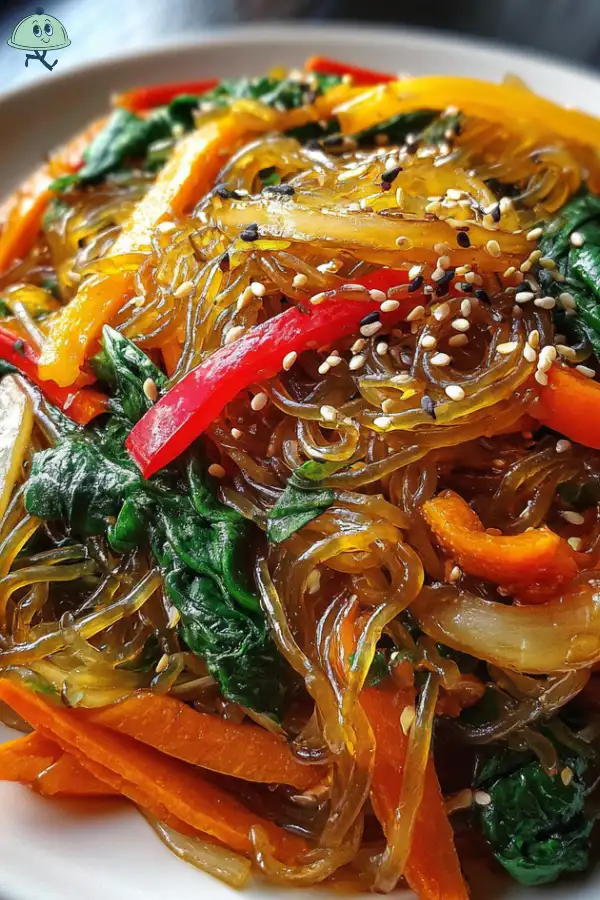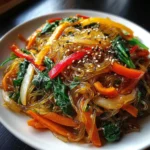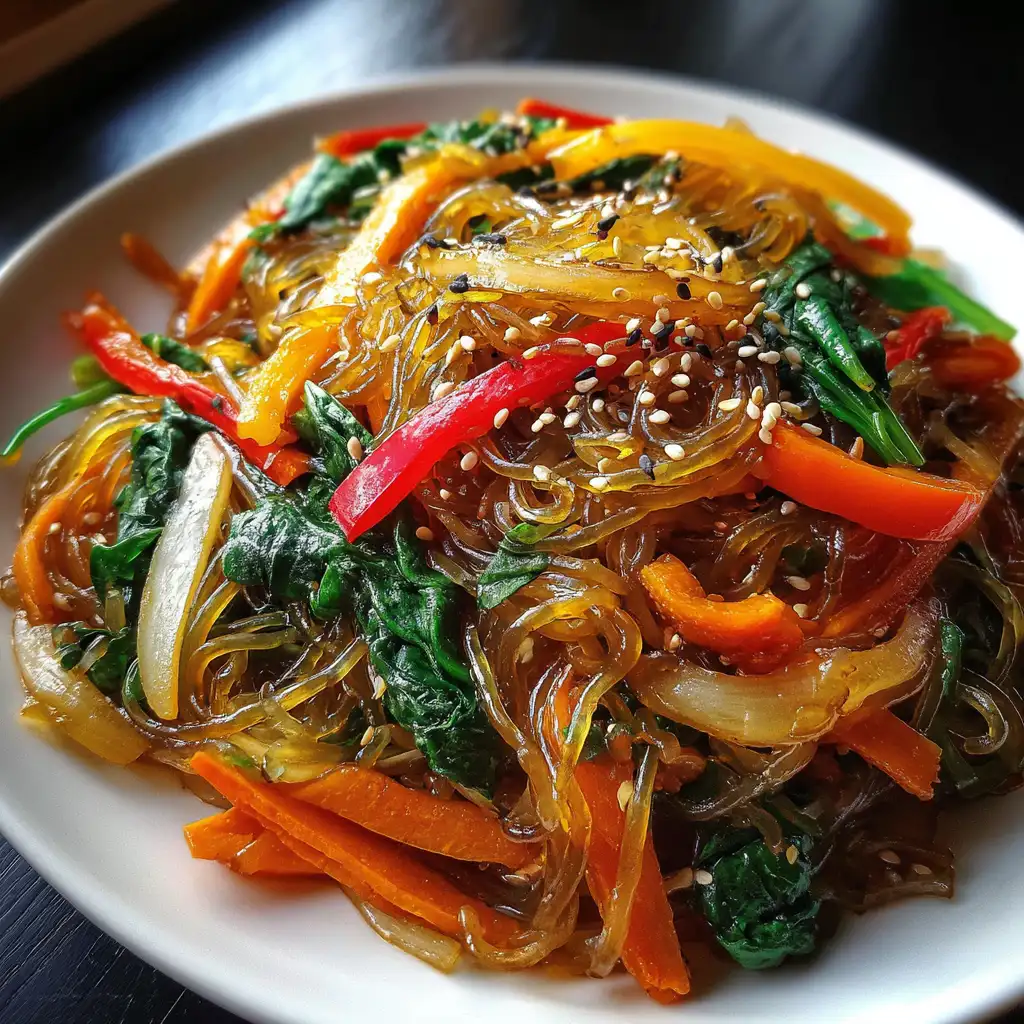Korean Japchae Noodles are a delightful dish made from sweet potato starch noodles, known as dangmyeon. These noodles are unique because they become chewy and slightly translucent when cooked. Japchae is not just about the noodles; it’s a colorful mix of vegetables, often including carrots, spinach, and bell peppers. The dish is seasoned with soy sauce and sesame oil, giving it a rich flavor. It can be served warm or at room temperature, making it a versatile option for any meal.
The History of Korean Japchae Noodles
The history of Korean Japchae Noodles dates back to the 17th century during the Joseon Dynasty. Originally, it was a royal dish served to the king and his guests. The name “Japchae” translates to “mixed vegetables,” which reflects the dish’s colorful ingredients. Over time, it became popular among common people and is now a staple in Korean cuisine. Today, Japchae is often enjoyed during celebrations, birthdays, and family gatherings. Its rich history and delicious taste make it a beloved dish in Korea and beyond.
Ingredients for Korean Japchae Noodles
Essential Ingredients for Korean Japchae Noodles
To create a delicious plate of Korean Japchae Noodles, you need a few essential ingredients. These ingredients not only provide flavor but also contribute to the dish’s vibrant colors and textures. Here’s what you’ll need:
- Sweet potato starch noodles (dangmyeon) – 200 grams: These noodles are the star of the dish, offering a chewy texture.
- Carrots – 1 medium, julienned: Carrots add a sweet crunch and bright color.
- Spinach – 150 grams, fresh: Spinach brings a lovely green hue and nutritional benefits.
- Bell peppers – 1 medium each of red and yellow, julienned: These peppers add sweetness and a pop of color.
- Onion – 1 medium, thinly sliced: Onions provide a savory base flavor.
- Garlic – 3 cloves, minced: Garlic enhances the overall taste with its aromatic qualities.
- Soy sauce – 4 tablespoons: This is the main seasoning that gives the dish its umami flavor.
- Sesame oil – 2 tablespoons: This oil adds a nutty aroma and richness.
- Vegetable oil – 2 tablespoons (for cooking): This oil is used for sautéing the vegetables.
- Sesame seeds – 1 tablespoon, toasted: These seeds are used as a garnish, adding a delightful crunch.
- Salt and pepper – to taste: These seasonings enhance the flavors of the dish.
Optional Ingredients to Enhance Korean Japchae Noodles
While the essential ingredients create a fantastic dish, you can also add optional ingredients to elevate your Korean Japchae Noodles. Here are some ideas:
- Protein: Consider adding beef, chicken, or tofu for a heartier meal. Cook the protein first, then mix it in with the noodles.
- Mushrooms: Shiitake or button mushrooms can add an earthy flavor and extra texture.
- Green onions: Chopped green onions can be sprinkled on top for a fresh finish.
- Eggs: A scrambled egg or a fried egg on top can add richness and flavor.
- Other vegetables: Feel free to include zucchini, broccoli, or any seasonal vegetables you enjoy.
These optional ingredients allow you to customize your Korean Japchae Noodles to suit your taste and dietary preferences. Enjoy experimenting with different combinations!
Preparation of Korean Japchae Noodles

Step-by-Step Instructions for Korean Japchae Noodles
Step 1: Soaking the Noodles
First, you need to soak the sweet potato starch noodles. Start by bringing a pot of water to a boil. Once boiling, add the 200 grams of sweet potato starch noodles. Cook them according to the package instructions, usually about 6-8 minutes. You want them to be soft and chewy. After cooking, drain the noodles and rinse them under cold water. This stops the cooking process and keeps them from getting sticky. Set the noodles aside for later.
Step 2: Preparing the Vegetables
Next, it’s time to prepare the vegetables. Take one medium onion and slice it thinly. Then, julienne one medium carrot and one medium bell pepper each of red and yellow. This means cutting them into long, thin strips. Finally, wash 150 grams of fresh spinach. Having all your vegetables ready will make cooking easier and faster.
Step 3: Cooking the Meat (if using)
If you decide to add protein, now is the time to cook it. You can use beef, chicken, or tofu. Heat a tablespoon of vegetable oil in a large skillet or wok over medium-high heat. Add your chosen protein and cook until it’s fully cooked through. Once done, remove it from the pan and set it aside. This step adds flavor and makes your dish more filling.
Step 4: Stir-Frying the Ingredients
Now, let’s stir-fry the vegetables! In the same skillet, add another tablespoon of vegetable oil. Start with the sliced onion and sauté for about 2 minutes until they soften. Then, add the julienned carrots and bell peppers. Cook these for another 3-4 minutes until they are tender but still crisp. Finally, stir in the fresh spinach and minced garlic. Cook for an additional 1-2 minutes until the spinach wilts and the garlic becomes fragrant.
Step 5: Combining Everything
It’s time to bring everything together! Add the cooked sweet potato noodles to the skillet with the sautéed vegetables. Pour in 4 tablespoons of soy sauce and 2 tablespoons of sesame oil. Toss everything gently to combine. Make sure the noodles are well coated with the sauce and mixed with the vegetables. Season with salt and pepper to taste. This step is crucial for ensuring every bite is flavorful!
Step 6: Serving the Korean Japchae Noodles
Once everything is heated through, remove the skillet from the heat. Transfer the delicious Korean Japchae Noodles to a serving dish. For a lovely finishing touch, sprinkle 1 tablespoon of toasted sesame seeds on top. You can serve this dish warm or at room temperature. It’s perfect as a main dish or a side dish for gatherings. Enjoy your homemade Korean Japchae Noodles!
Tips for Perfecting Korean Japchae Noodles
Common Mistakes to Avoid with Korean Japchae Noodles
When making Korean Japchae Noodles, it’s easy to make a few common mistakes. Here are some pitfalls to watch out for:
- Overcooking the Noodles: One of the biggest mistakes is overcooking the sweet potato starch noodles. They should be soft yet chewy. Always follow the package instructions and rinse them under cold water after cooking.
- Not Preparing Ingredients Ahead: Failing to prep your vegetables can lead to uneven cooking. Always chop and measure your ingredients before you start cooking.
- Skipping the Rinsing Step: After cooking the noodles, rinsing them under cold water is essential. This prevents them from sticking together and keeps their texture perfect.
- Using Too Much Soy Sauce: While soy sauce adds flavor, using too much can make the dish overly salty. Start with the recommended amount and adjust to taste.
- Not Stirring Enough: When combining the noodles and vegetables, be sure to toss everything well. This ensures that every bite is flavorful and well-mixed.
Best Practices for Cooking Korean Japchae Noodles
To achieve the best results with your Korean Japchae Noodles, consider these best practices:
- Use Fresh Ingredients: Fresh vegetables not only taste better but also add vibrant colors to your dish. Choose seasonal produce for the best flavor.
- Cook in Batches: If you’re making a large quantity, consider cooking the ingredients in batches. This helps maintain the right texture and prevents overcrowding in the pan.
- Adjust Seasonings: Taste as you go! Adjust the soy sauce, sesame oil, and seasonings to suit your preference. Everyone’s taste is different, so make it your own.
- Garnish for Presentation: Don’t forget to garnish your dish! A sprinkle of toasted sesame seeds or chopped green onions can elevate the presentation and add extra flavor.
- Serve at the Right Temperature: Japchae can be enjoyed warm or at room temperature. If serving at room temperature, let it cool slightly before serving to enhance the flavors.
By avoiding common mistakes and following these best practices, you’ll create a delicious and visually appealing plate of Korean Japchae Noodles that everyone will love!
Variation of Korean Japchae Noodles
Vegetarian Options for Korean Japchae Noodles
If you’re looking for a vegetarian version of Korean Japchae Noodles, you’re in luck! This dish is naturally adaptable to suit a plant-based diet. Here are some delicious vegetarian options to consider:
- Tofu: Firm tofu is a great protein source. Simply cube it and sauté until golden brown before adding it to the noodles.
- Tempeh: For a nutty flavor, try using tempeh. Slice it thinly and cook it in the same way as tofu.
- Mushrooms: Add shiitake or portobello mushrooms for a meaty texture. They absorb flavors well and enhance the dish.
- Extra Vegetables: Feel free to load up on more vegetables! Zucchini, broccoli, or snap peas can add variety and nutrition.
- Eggs: If you eat eggs, consider adding a scrambled egg or a fried egg on top for added richness.
These vegetarian options not only make the dish heartier but also keep it colorful and nutritious. Enjoy customizing your Korean Japchae Noodles to fit your dietary needs!
Gluten-Free Alternatives for Korean Japchae Noodles
For those who need to avoid gluten, Korean Japchae Noodles can still be enjoyed with a few simple adjustments. Here are some gluten-free alternatives:
- Gluten-Free Soy Sauce: Regular soy sauce contains gluten, so opt for tamari or a gluten-free soy sauce. This will keep the flavor intact without the gluten.
- Rice Noodles: If you can’t find sweet potato starch noodles, rice noodles are a great substitute. They offer a similar texture and are gluten-free.
- Check Labels: Always check the labels of your ingredients, especially sauces and seasonings, to ensure they are gluten-free.
- Fresh Vegetables: Stick to fresh, whole vegetables, as they are naturally gluten-free. This keeps your dish healthy and safe for gluten-sensitive individuals.
By making these simple swaps, you can enjoy a delicious plate of Korean Japchae Noodles that fits your gluten-free lifestyle. It’s all about enjoying the flavors while staying true to your dietary needs!
FAQs about Korean Japchae Noodles
How do you store leftover Korean Japchae Noodles?
Storing leftover Korean Japchae Noodles is simple! First, let the noodles cool down to room temperature. Then, place them in an airtight container. You can keep them in the refrigerator for up to three days. When you’re ready to enjoy them again, just reheat in a pan over low heat. You might want to add a splash of water or a little oil to keep them from drying out. This way, you can savor the delicious flavors of your Japchae even after a day or two!
Can you freeze Korean Japchae Noodles?
Yes, you can freeze Korean Japchae Noodles! To do this, let the noodles cool completely. Then, portion them into freezer-safe bags or containers. Make sure to remove as much air as possible to prevent freezer burn. They can be stored in the freezer for up to three months. When you’re ready to eat, thaw them in the refrigerator overnight. Reheat in a pan, adding a bit of water or oil to restore their texture. Freezing is a great way to enjoy your Japchae later!
What can I serve with Korean Japchae Noodles?
Korean Japchae Noodles are versatile and can be served with various dishes. Here are some great options:
- Rice: Serve Japchae alongside steamed white or brown rice for a complete meal.
- Korean BBQ: Pair it with grilled meats like bulgogi or galbi for a delicious feast.
- Kimchi: A side of kimchi adds a spicy and tangy flavor that complements the noodles.
- Salad: A fresh vegetable salad can provide a crunchy contrast to the soft noodles.
- Soup: A light soup, like miso or seaweed soup, can round out the meal nicely.
These pairings enhance the dining experience and make your meal even more enjoyable!
How long does it take to make Korean Japchae Noodles?
Making Korean Japchae Noodles is quite quick! From start to finish, it usually takes about 30 to 40 minutes. This includes the time to soak and cook the noodles, prepare the vegetables, and stir-fry everything together. If you’re adding protein, it might take a few extra minutes. Overall, it’s a relatively fast dish to prepare, making it perfect for weeknight dinners or special occasions!
Print
Korean Japchae Noodles
- Prep Time: 15 minutes
- Cook Time: 25 minutes
- Total Time: 40 minutes
- Yield: 4 servings
- Category: Main Dish
- Method: Stir-frying
- Cuisine: Korean
- Diet: Vegetarian
Description
Korean Japchae Noodles are a delightful dish made from sweet potato starch noodles, mixed with colorful vegetables and seasoned with soy sauce and sesame oil.
Ingredients
- Sweet potato starch noodles (dangmyeon) – 200 grams
- Carrots – 1 medium, julienned
- Spinach – 150 grams, fresh
- Bell peppers – 1 medium each of red and yellow, julienned
- Onion – 1 medium, thinly sliced
- Garlic – 3 cloves, minced
- Soy sauce – 4 tablespoons
- Sesame oil – 2 tablespoons
- Vegetable oil – 2 tablespoons (for cooking)
- Sesame seeds – 1 tablespoon, toasted
- Salt and pepper – to taste
Instructions
- Soak the sweet potato starch noodles in boiling water for 6-8 minutes, then drain and rinse under cold water.
- Prepare the vegetables by slicing the onion, julienning the carrots and bell peppers, and washing the spinach.
- If using protein, cook it in a skillet with vegetable oil until fully cooked, then set aside.
- In the same skillet, sauté the onion for 2 minutes, then add the carrots and bell peppers, cooking for another 3-4 minutes.
- Add the spinach and garlic, cooking for an additional 1-2 minutes until the spinach wilts.
- Combine the cooked noodles with the sautéed vegetables, adding soy sauce and sesame oil, and toss to mix well.
- Serve the noodles in a dish, garnished with toasted sesame seeds, warm or at room temperature.
Notes
- Use fresh ingredients for the best flavor.
- Adjust seasonings to taste.
- Can be served as a main dish or side dish.
- Store leftovers in an airtight container in the refrigerator for up to three days.
- Freezing is possible; store in freezer-safe bags for up to three months.
Nutrition
- Serving Size: 1 serving
- Calories: 250
- Sugar: 3g
- Sodium: 600mg
- Fat: 10g
- Saturated Fat: 1g
- Unsaturated Fat: 9g
- Trans Fat: 0g
- Carbohydrates: 35g
- Fiber: 3g
- Protein: 6g
- Cholesterol: 0mg
Keywords: Korean, Japchae, Noodles, Stir-fry, Vegetarian, Recipe

